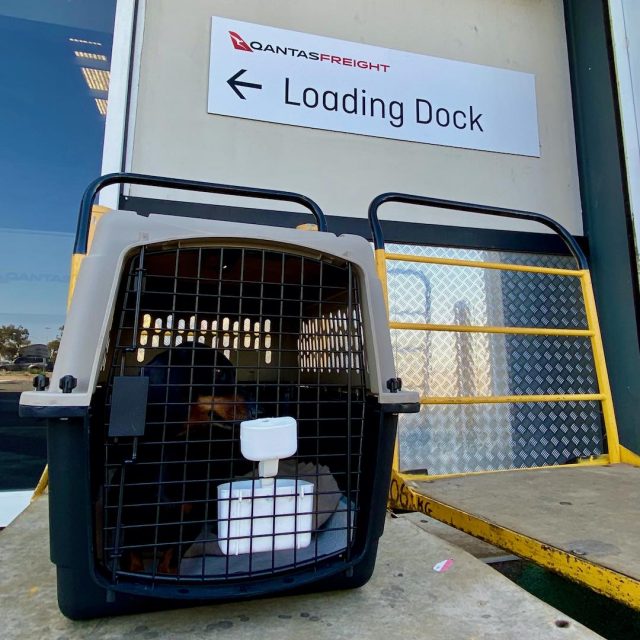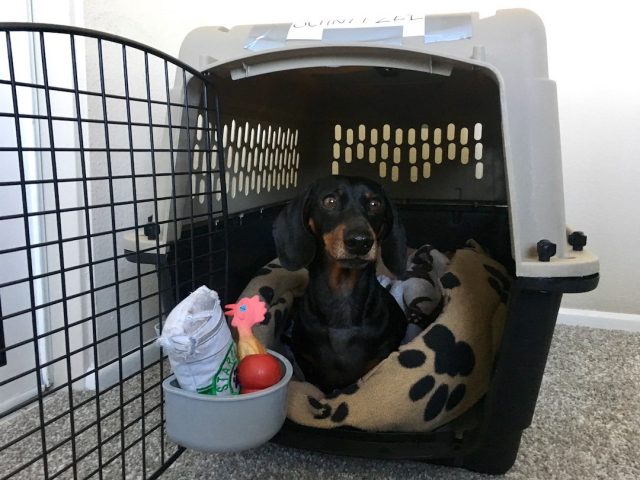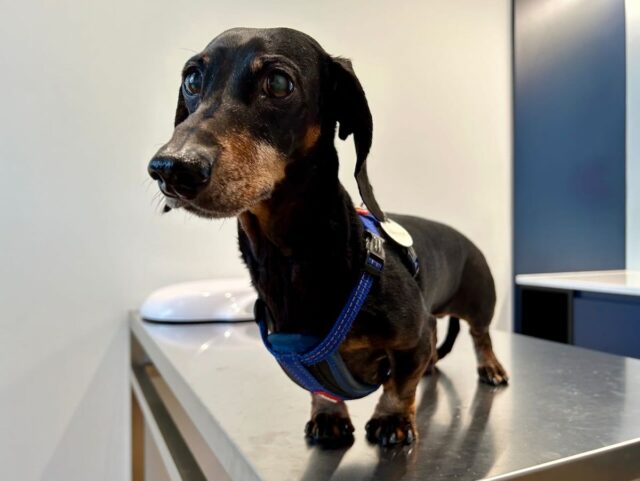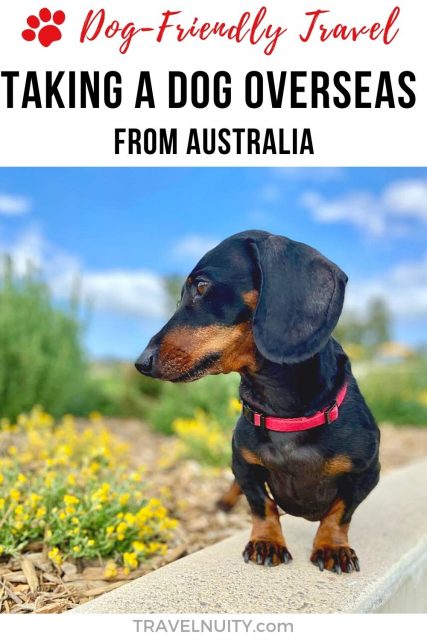It’s a big task taking pets overseas from Australia. There’s a wide range of things that you need to organise, from your pet’s flights to vaccinations to the export permit. Plus preparing for your pet to return, if it’s not a permanent move. I’ll take you through everything you need to consider…

Should You Take Your Dog Overseas from Australia?
Firstly, you should consider whether you really should take your dog overseas from Australia. This is due to a combination of three factors: the need to fly your dog in cargo (they can’t fly in the cabin), the complicated process to bring your dog back to Australia, and the cost. International pet travel from Australia is complicated.
If you’re just going overseas for a month or two on holiday, don’t consider taking your dog, unless they’re an assistance dog. (Or if you’re flying in a private jet, with cost not an issue!) Consider instead leaving your dog behind with friends and family or a pet-sitter.

But if you’re going overseas for a longer period, say six months or longer, it’s more feasible, as long as you’re fine with the cost. When we travelled around Europe and the USA with our dog, Schnitzel, we ended up being away for 20 months. Naturally, of course, if you’re permanently heading overseas, you’ll want to move overseas with your dog.
An extra consideration is that pets cannot be imported directly back into Australia from many countries. Pets can only be directly imported from the approved Group 1, 2 and 3 countries listed on this page. If you’re heading to an unapproved country with your dog, your dog will need to stay in an approved country for 180 days first before returning to Australia.

Cost of Taking Pets Overseas from Australia
It is far more expensive to fly your pet overseas from Australia than your own flight, even if you splurge for business class seats.
Make sure you budget for the following costs:
- Vet visits, usually at least a rabies vaccination and an export health check
- Government Health Certificate and Export permit
- Approved travel crate
- The actual flights, usually the most expensive component
- Pet transport company charges, which may include some or all of the above costs, plus transportation and boarding
- Custom charges at your destination
When I flew with my pet overseas in 2017, from Sydney to Madrid, the total cost of taking my pet overseas from Australia was over $3000, including the above fees.
Since then, prices have generally increased, especially since 2020 when many freight charges have increased. I recently requested a quote for my pet to fly with a pet transport company from Sydney to Vancouver, a shorter direct flight, and was quote around $3000, not including a rabies vaccination, crate or airport charges at the destination.
Booking Flights for Your Dog
As I mentioned above, when dogs leave Australia they need to fly as cargo in the hold of the plane. This is an Australian government regulation that applies to all animals except registered assistance animals. Many major airlines flying to and from Australia will fly animals as cargo, including both Qantas and Virgin Australia.
In order to fly your pet out of Australia, you will generally need to book through a pet transport company. On selected flights without a transit, Qantas has previously accepted direct bookings for pet freight, such as when I flew my dog back from Los Angeles.
Between 2020 and 2022, it was not possible to book directly with Qantas, but I believe this is again possible – double check by calling up the Freight department. As far as I’m aware, every other airline flying to and from Australia requires you to book through a pet transport company.

The advantage of being required to book with an animal transport company is that they’re pros at flying pets, and can step you through all the requirements. They can also have a crate delivered to you for your pet to fly in. I used Jetpets when I first headed overseas.
When pets fly as cargo, they fly in the hold of the plane, which isn’t quite as scary as it sounds. There’s a special compartment for flying animals, that is temperature and pressure controlled, similar to the passenger cabin, with dimmed lights. However, some pets are at increased risk when flying, including brachycephalic breeds and older pets.
Don’t Forget Crate Training
When your dog is flying in the hold, they will fly in a large, sturdy crate, which must meet the requirements set out by the International Air Transport Association (IATA). You can buy a flight crate off a pet transport company, some airlines or many larger pet stores. In the latter case, be careful to ensure it meets all the requirements, especially the minimum size requirements.
To reduce the stress of flying for your dog, it’s best to crate train your dog well in advance. I luckily crate trained my dog as a puppy, so he quickly settled into his flight crate, but even older dogs can be trained. Ideally introduce your dog to their actual flight crate as soon as possible, but you can also start crate training in an alternative crate.

Firstly introduce your dog to their crate by allowing them to sniff it and perhaps go inside of it. Encourage them go go inside and make positive associations with it by feeding them inside the crate.
Ideally, when your dog comes to be transported in their crate, they willingly enter it and lie down inside, perhaps even sleeping inside it. This will greatly decrease their stress from the journey and experience. Although it always helps to add a favourite blanket or an old t-shirt with your smell on it, to help settle them down.
Preparations for Your Destination Country
Depending on the country your are travelling to with your pet, there are likely a range of requirements for your pet to enter the country. These rules and regulations are published on government websites, or if you use a pet transport company they will be aware of the requirements. The Australian government also maintains a Manual of Importing Country Requirements as a guide.
At a minimum, many countries require your dog to have been vaccinated against rabies. As an example, if you’re travelling to the EU with your dog from Australia, as was the case when I headed overseas, your dog will need to be microchipped (if not already), vaccinated for rabies and you’ll need to complete the EU pet health certificate.
If you’re travelling to the United States with your dog from Australia, there is no longer any need to show a rabies vaccination certificate for your dog. But it’s best to still vaccinate your dog against rabies, due to rabies being present in the country and individual state requirements.

Some countries also have additional, more complex requirements. However, only a handful of countries other than Australia require quarantine for all arriving pets. Plus, often the requirements are less onerous for pets flying from Australia, due to our rabies-free status and lack of other diseases.
Visiting a Registered Veterinarian
All preparations for your pet to head overseas need to be done by a fully registered veterinarian. This includes both any rabies vaccinations and a final veterinarian inspection before your pet’s export permit (see below) is issued.
Before starting preparations, find out if your vet is fully registered and if they are not, ask for their recommendation for another vet. The following information pack exists for vets.

As rabies vaccinations are not common in Australia, only given to animals heading overseas, plenty of notice is required before the vaccination appointment with your vet. Note that your veterinarian will issue you a rabies vaccination certificate afterwards. Always keep the original copy secure, just like your own passport. This certificate will later be endorsed as part of the export permit appointment.
Organising an Export Permit
Some countries have export requirements for pets leaving the country, and Australia is one of those countries. The government mandates a two-step export process for pet dogs and cats leaving the country. Firstly, you need to complete a Notice of Intention to Export. Secondly, you need to schedule an appointment where an export permit and health certificate is issued, shortly before departure.
If you are exporting your pet with a pet transport company, it is likely that they will organise these steps for you. When I exported my dog, I wasn’t even aware of this process, though I knew my dog had to be picked up to see a vet and complete his paperwork the day before his flight.
For detailed information on this process, see my post on exporting a dog from Australia.

Prepare for Your Return to Australia
If you’re not moving overseas with a pet permanently from Australia, keep in mind what is required for your pet to return to Australia. The steps to import a dog to Australia, even one originally from Australia, are quite complicated and quarantine is required for all pets from overseas countries, except those flying from New Zealand.
As I mentioned above, it’s even more complicated to transport a pet back to Australia from unapproved countries, requiring a long stay in an intermediate country.
While it’s expensive to fly a pet overseas from Australia, it’s even more expensive to bring your pet back to Australia. In addition to the cost of the flight, there’s also quarantine fees, import permit fees and multiple expensive vet visits. Make sure you can handle these costs before firstly taking your pet overseas from Australia.

To make things easier for when your return to Australia with your pet, I recommend you have a rabies titre test done before you leave, about a month after your dog’s rabies vaccination. This test is required for dogs travelling to Australia from most countries, except a short list of rabies-free countries.
If you have this test done overseas, a waiting period of 180 days applies before your pet can fly back to Australia. However, if your dog has the test done in Australia before leaving, no waiting period applies.
Unfortunately, during March 2023 the validity period of this test for the purpose of importing a dog to Australia was reduced from 24 months to one year. It’s still a good idea to have one done before leaving Australia, in case circumstances change and you want to come back quickly.
Check out more of my tips on importing a dog to Australia.
You May Also Like
- Exporting a Dog from Australia
- Bringing a Dog to Australia: My Experience
- How Much Does It Cost to Bring a Dog to Australia?
About the Author

Shandos Cleaver is the founder of Travelnuity: Dog-Friendly Travel. She has travelled extensively with her Miniature Dachshund, Schnitzel, including to 33 countries across Europe, every state and territory of Australia except Tasmania, and 10 of the United States. She’s passionate about providing inspiration and information to others wanting to travel with their dogs, whether close to home or internationally.
Inspired? Pin this to your Pinterest board!


How long is the quarantine on return and can you visit your dog while they are in quarantine?
Quarantine is 10 days, and no visits are possible. Keep this in mind before deciding to head overseas.
Are they in the crate for ten days? Or let out? How does that work?
They have individual kennels with indoor and outdoor areas – see my linked post on quarantine.
Hi
What kind of flight cost is involved with a small dog?
Expect to pay at least $2000-3000 AUD to fly a small dog overseas, possibly more since Covid. Returning to Australia with your dog is more expensive, due to the additional fees for quarantine, an import permit and vet visits. For more information, see: https://www.travelnuity.com/cost-of-bringing-a-dog-to-australia/
I am planning to move to London for 1-2 years and don’t know what the best decision is for my 5 year old Kelpie. I keep going back and forth between taking her with me or leaving her with a friend. The thought of her flying is very scary and I feel cruel for subjecting her to that. What do you think?
It’s a tough decision! Most dogs actually do better than their parents expect flying in the hold. I’ve based this on conversations with a number of people who have moved to or from Australia with their dogs. However, there’s a chance they may react badly, and if you’re returning to Australia in a year or two, it’s not an ideal situation. Not to mention, there’s the factor of cost. If you didn’t have someone ideal to leave your pup with, I’d recommend taking her, but if you have someone trustworthy you could leave her with, especially if you might only be gone for a year, you could go either way.
What if the dog needs daily meds? Two/Three times a day…
Would they take care of this? Do you know how that would work?
I recommend sending an email to ask. They should be able to do this, but the medicine may need to be sourced in Australia.
Do they tranquillise or medicate the dogs at all to keep them calm on long-haul flights?
It’s discouraged to sedate dogs, but if you feel it is necessary, discuss and trial the medication with your vet. My dog has never been sedated on multiple flights, he’s fine without anything.
Can I please get some advice urgently please, this is the first time I am travelling over seas with my Dog, little 12 kg pug cross Australian terrier is not in good health but I love 💕 him more than any thing and would never ever part with him.. also the travelling time, quarantine time,, is a big concern to me please can anyone help me with advice going from Goldcoast Qld Australia moving to Cedub Phillipeans….. thank you Colin and Bear…….
I’ve sent you an email.
Thanks Shandos. Your blog has been so helpful to me understanding the process before planning our move to NYC. How long before departing Australia do you recommend starting the process (at a minimum) if we need to get the rabies vaccination, rabies titres test and health check/certificate? Just wondering if this is something that can be taken care of by a company or someone else if I head overseas ahead of my pet to get set up etc. and then have them shipped over.
We only started the process just over a month before flying out. The main requirement is the wait between the rabies vaccine and titre test, but as you don’t need the titre test for the USA, just returning to Australia, you can risk flying out before receiving the test result.
Most pet transport companies can organise this for you, especially the final health check and paperwork. The company we used picked up our dog a day before the flight to finalize everything and put him on the plane.
Hi Shandos . Thankyou for your wonderful info and your site
We have 2 Miniature Dacshunds and have considered taking them to Europe on January. At the initial stages of organising via Jetpets. Have thought about long and hard as at present we plan on returning in August. May opt for leaving them with a trusted friend who will most certainly spoil them big time.
I hope whatever you decide to do, it all goes smoothly. It’s a big task taking dogs overseas from Australia (and returning)!
Hi Shandos,
My wife and I are relocating back to Spain in February 2024 and taking our very much-loved Border Collie with us, the only issue we have is that we are unable to find an insurer that offers any type of travel insurance one-way for our pet. Does this type of policy even exist? Everyone we call don’t offer this service.
Are you able to shed some light on this please.
Thank you
Luis & Maria
Sorry, I haven’t come across this type of insurance for pet travel in Australia. I have only heard of some policies in the USA and Europe where there is coverage in other countries. You may like to double check with the pet transport company you are using, but I have a feeling this doesn’t exist.
Hi Shandos,
Lovely post and so informative. Could I please ask how difficult it is to fly with dachshund to India for 5 years? Leaving him isn’t an option and I’m also thinking would he get used to the air quality in India?
Really hoping to get some help on this 💜
Cheers,
Ed
I’m not that familiar with people taking their dogs to India, as India only approves import permits for dogs if you are relocating, not for holiday visits. The major issue I can see is returning to Australia with your dog later – India is not an approved country, so your dog would need to spend 6 months in another country being prepared for the import to Australia (and still require quarantine as well). The issues with air quality in India are mainly seasonal, over the winter, and I must admit our air quality during the 2019-20 bushfires was far worse than anything in India, so I wouldn’t view this as a major issue.
I was hoping to know how I can book a flight from Australia to Iran for my pets,
Your best option will be to book with a pet transport company here in Australia. You will probably need to fly to Dubai with Qantas or Emirates then transfer to a second flight. This is what I did to fly to Spain with my dog. He was taken to the kennel at Dubai Airport during the stopover.